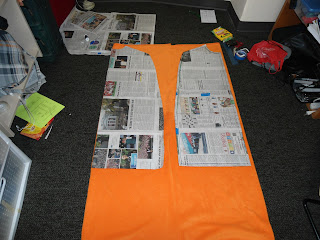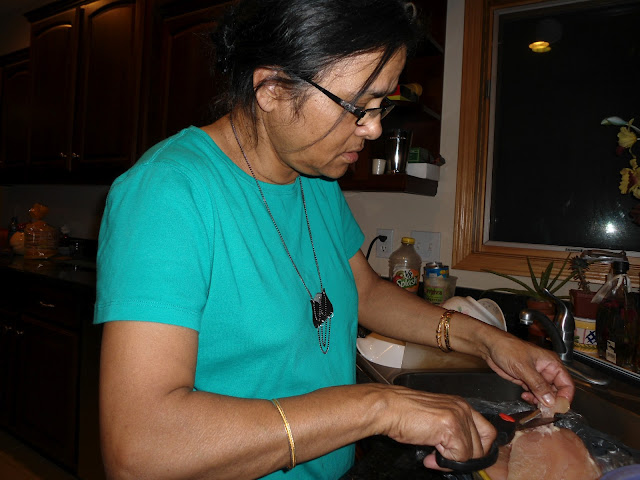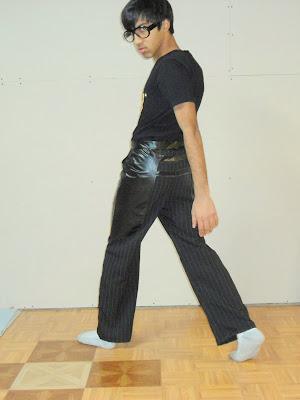I love Raglan sleeve anything. Raglan sleeves are not the normal way sleeves are made. In fact, there are some shirts where the diagonal lines are incorporated into the shirts, but the sleeves are still set-in sleeves. I guess people do that because the lines look so good! Raglan sleeves have an interesting way to making the upper chest area look so good!
So I wanted to make something with raglan sleeves. I'm still not good at making sleeves, so I had to think of a way to "cheat." Well, fortunately, I know that jersey stretches. I used that fact to try making my first raglan shirt!
1) Find a shirt! I used a one of my uniform t-shirts because I wanted to add a little bit of uniqueness (also I had a spare that I could use in case I got in trouble!)
2) Mark sew line and seam allowance. I looked at raglan sleeves to figure out where the sew lines needed to go. After making the sew line, I added the seam allowance. The picture only shows the sew line. (In the picture you'll notice that there are double lines under the sleeve... that's just a mistake I made. I realized that the sew line needed to be lower so that I could have a seam allowance.)
2) Cut the shirt! Start by cutting off the collar. Then cut the shirt on seam allowance line. Keep the sleeve portion. This sleeve will be used to make the raglan sleeve.
3) Make the raglan sleeve pattern. To do this take take the cut away portion from step 2 and cut it open (follow the underarm seam). Then trace and add seam allowances.
Things to note:
a) Mark the front and back.
b) FIRST trace the diagonal lines (the ones that cross the chest and back). Then add the seam allowance to these diagonal lines. This won't be the actual seam allowance; this will be the sew line. Then extend the sew line the seam allowance amount (add this to the bottom). Then add seam allowance again for the actual seam allowance.
c) Trace the top (the portion that was connected to the collar) as is. Do not add seam allowances. Then connect this line to the two diagonal lines you constructed in part b. You might need to play around with this curve.
d) Make the under arm lines. To do this take start at the bottom of the diagonal lines made in part a and go down. I can not give really good directions on this part... sorry...
(The picture below only shows part of part a.)
4) Take the completed pattern and put in on an old shirt. Then cut out the sleeve. I used a contrasting color for the sleeves. In the picture below, the sleeve pattern clearly doesn't fit the shirt. That's fine; I just had to be happy with shorter sleeves!
5) Make bias tape.
Usually for knits, people turn in unfinished sides and use the cover stitch. Unfortunately I do not have the machine necessary make a cover stitch. Also, I don't have the right fabric for the collar. So I decided to use bias tape to finish the edges (collar and sleeve opening). I did this because people use bias tape to cover rough edges so that they do not fray.
Real bias tape is fabric cut on the diagonal grain. Bias tape is made this way so that it will stretch for easier use around corners. Well, I cheated on this step, too. I know knits are stretchy. Because of this lovely quality, I just cut out two inch thick strips. I cut these strips out of the remaining shirt pieces so that it can stay the same color. After I cut the strips, I folded long sides into the middle, and then I hot dog folded it (for a better explanation of this double fold, please look at real bias tape!) Then I ironed it down to keep the folds in place. Pins helped me a lot in this step.
5) Sew the shirt!
First attach the sleeves. Because there are no sides seams on the body, you have to add the sleeve in a set-in sleeve matter. So first sew the under arm seam, and then attach the sleeve to the body.
Then, add the bias tape!
I'm really happy with the result! It looks like a raglan shirt, so I can't really complain! The only issue is the collar. In a "normal," mass-market shirt, the collar tapers down. In this shirt, the collar sort of sticks out because the bias tape is the same length as the collar hole. Oh, well. I'm willing to over look that fact.
What really excites me is that this is another great
RECYCLING project! I took old shirts and made a new one.






















































